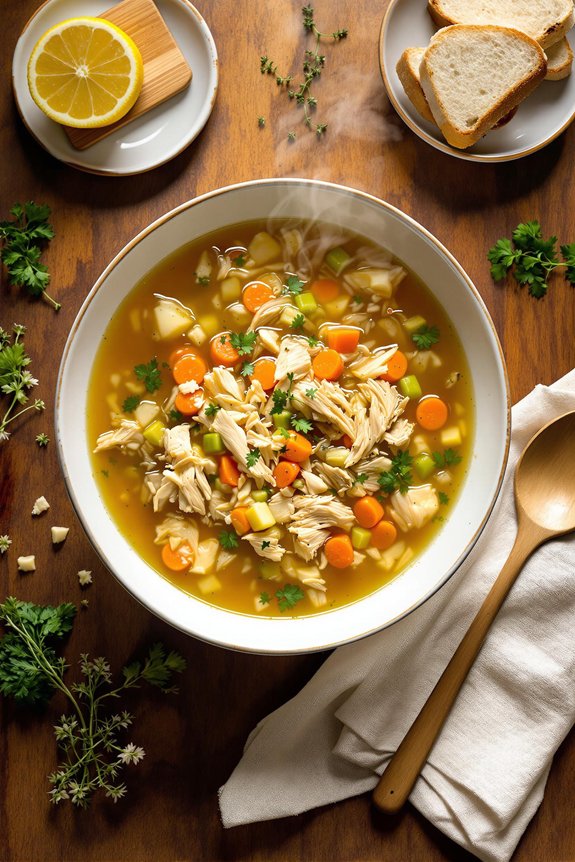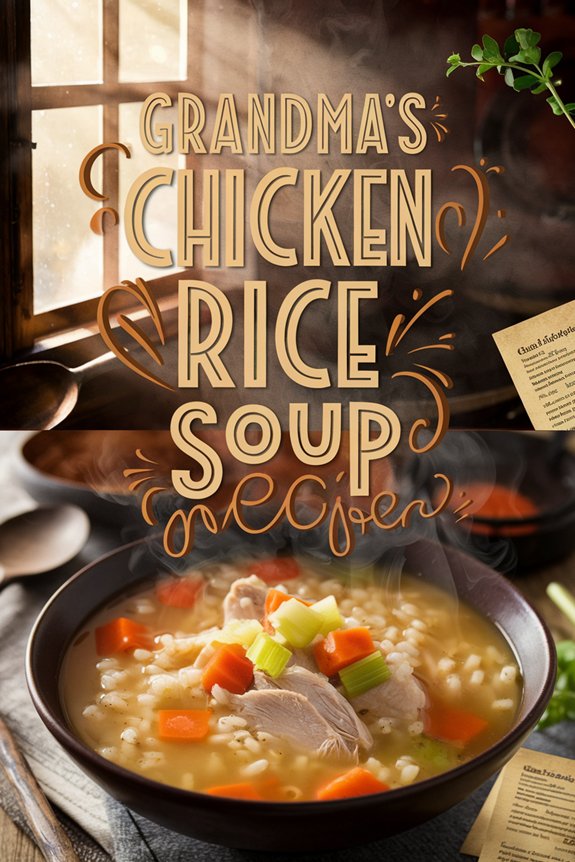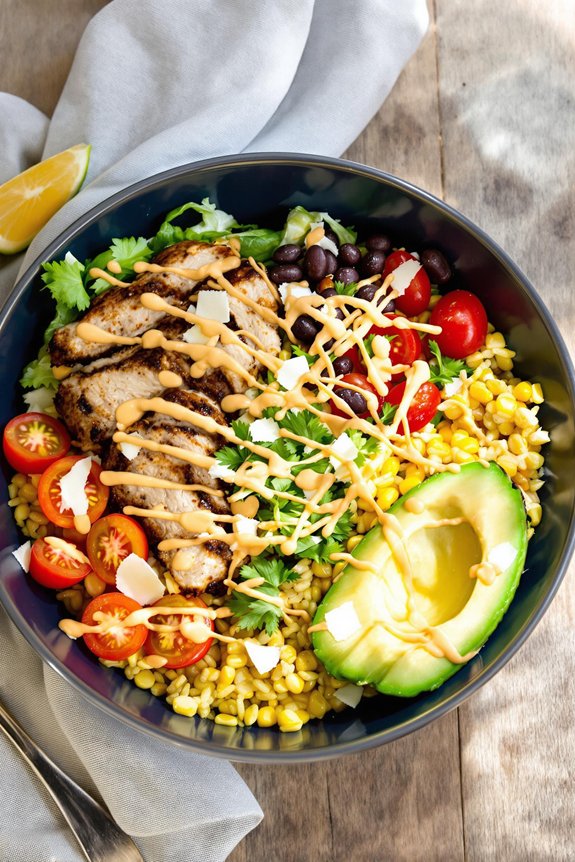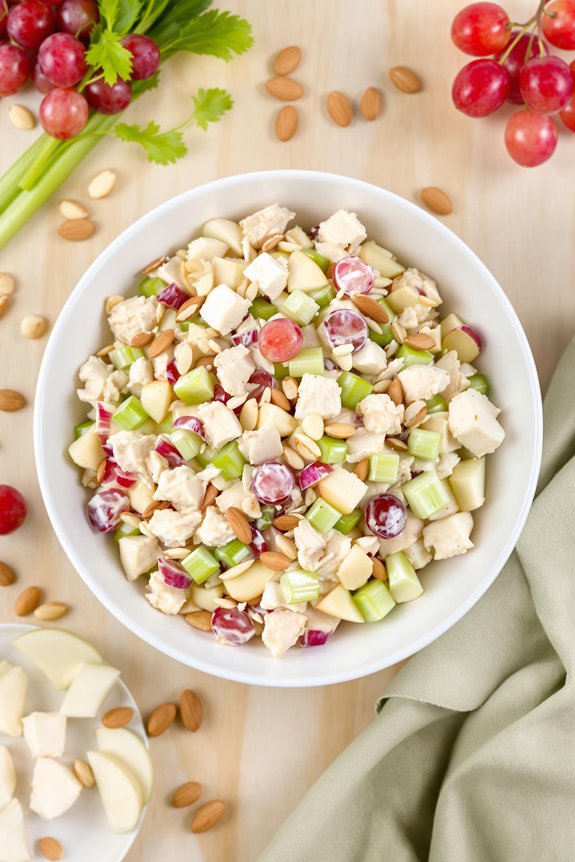Why You’ll Love this Healing Chicken Rice Soup
When the cold weather hits or someone at home starts sniffling, nothing quite compares to a steaming bowl of homemade chicken rice soup.
I’m convinced this recipe is pure comfort in a bowl. The tender chunks of chicken, perfectly cooked rice, and bite-sized vegetables create a harmony of flavors that soothes from the inside out.
What makes this version special? It’s the slow-simmered broth that extracts every bit of goodness from the ingredients.
The hint of bay leaf, the warmth of black pepper—it’s like a gentle hug for your immune system. Truly restorative.
What Ingredients are in Healing Chicken Rice Soup?
Grandma’s healing chicken rice soup is all about simple, nourishing ingredients that work together to create something truly magical. This isn’t one of those recipes with fancy ingredients you’ll never use again—it’s a back-to-basics approach that delivers incredible flavor and comfort.
The foundation is a rich, slow-simmered broth that extracts all the goodness from chicken and aromatics, while hearty vegetables and rice make it substantial enough for a complete meal.
- 3½ pounds diced chicken
- 3 gallons water
- ½ ounce bay leaf
- 3 tablespoons salt
- 3½ cups celery, diced
- 3½ cups carrots, diced
- 3⅛ cups white rice
- 1½ tablespoons black pepper
- Onion, chopped (mentioned in instructions but not in ingredients list)
What I love about these ingredients is how adaptable they are. Don’t have quite enough carrots? No problem. Want to add a bit of garlic or fresh herbs? Go right ahead.
The beauty of grandma-style cooking is that measurements are more of a suggestion than a rule. Though I do recommend sticking close to the chicken-to-water ratio to guarantee you get that deeply flavorful broth that makes this soup so healing and restorative.
And remember, the quality of your ingredients matters—fresh vegetables and good quality chicken will elevate this simple soup to something truly special.
How to Make this Healing Chicken Rice Soup

Making Grandma’s healing chicken rice soup is a wonderfully meditative process—the kind that fills your kitchen with mouthwatering aromas and gives you plenty of time to decompress while stirring occasionally.
To begin, grab your largest stock pot and combine 3½ pounds of diced chicken with 3 gallons of water. This might seem like a lot of water, but trust me, it creates the perfect base for this deeply nourishing soup. Add ½ ounce of bay leaf, 3 tablespoons of salt, and 1½ tablespoons of black pepper to season the broth. Bring this mixture to a boil, which helps release all those wonderful flavors from the chicken.
Once boiling, add 3⅛ cups of white rice directly to the pot.
Now comes the part where patience truly becomes a virtue. Let the soup simmer gently for 3-4 hours, giving it an occasional stir to prevent the rice from sticking to the bottom of the pot. There’s something so soothing about watching a pot of soup slowly transform, don’t you think?
After the lengthy simmer, remove the chicken pieces and allow them to cool just enough that you can handle them. Debone the chicken and cut the meat into smaller, bite-sized pieces.
While working with the chicken, wash and prep your vegetables: 3½ cups of diced celery, 3½ cups of diced carrots, and don’t forget to chop an onion (though the recipe doesn’t specify the amount, I’d suggest one medium onion).
Return the deboned chicken to the pot and add all your prepared vegetables. Cover the pot and continue simmering for about another hour, allowing the vegetables to soften and release their flavors into the broth.
During this final cooking stage, keep an eye on the water level—the recipe wisely notes to “replace water as necessary” since some will inevitably evaporate during the long cooking process. For an easier hands-off approach, you could use premium multicookers available now that maintain perfect temperature and moisture levels.
The finished soup should have a perfect balance of tender chicken, soft rice, and vegetables swimming in a rich, aromatic broth. This is truly the definition of comfort food, the kind that warms you from the inside out and, as the name suggests, has healing properties that seem to work magic on both body and soul.
Healing Chicken Rice Soup Substitutions and Variations
Although Grandma’s recipe creates pure magic in a bowl, you’ll be happy to know this soup offers incredible flexibility for dietary needs or whatever happens to be in your pantry.
Can’t handle gluten? Simply swap the white rice for brown rice or quinoa.
Vegetarians can omit the chicken and use vegetable broth instead—still delicious, I promise.
For extra flavor, try adding fresh herbs like dill or parsley. A squeeze of lemon brightens everything up.
And those leftover vegetables threatening to wilt in your crisper drawer? Toss them in. Zucchini, spinach, turnips—they all work beautifully in this forgiving recipe.
What to Serve with Healing Chicken Rice Soup
While this soul-warming soup can certainly stand on its own as a complete meal, pairing it with complementary sides elevates the entire dining experience.
I love serving freshly baked crusty bread or fluffy dinner rolls for dipping into that rich, savory broth. Who doesn’t enjoy sopping up those last precious spoonfuls?
A simple green salad with a light vinaigrette provides a revitalizing contrast to the hearty soup.
For something more substantial, try grilled cheese sandwiches—the ultimate comfort food duo.
When I’m feeling fancy, I’ll add a cheese board with crackers and fruit, creating a casual, café-style lunch that’s perfect for chilly afternoons.
Final Thoughts
As grandma always said, this soup isn’t just a recipe—it’s a tradition passed down through generations.
There’s something magical about the way the chicken, rice, and vegetables come together in that rich broth. The aroma alone can transport you back to childhood sick days when nothing else would do.
I believe the secret lies in the slow simmer and generous seasoning. The time you invest pays off in flavor.
Don’t you think comfort food always tastes better when shared?
This recipe makes plenty, so invite neighbors or freeze portions for later. Some traditions are worth preserving.





